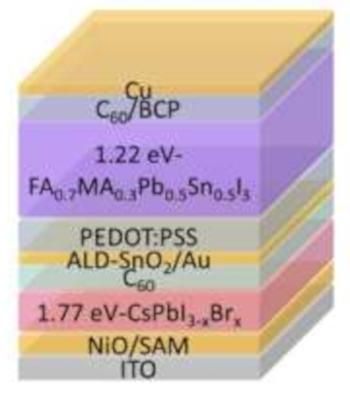Researchers at Nanjing University, Nankai University, East China Normal University and University of Toronto have developed new inorganic wide-bandgap perovskite subcells that could increase the efficiency and stability of all-perovskite tandem solar cells. Their design involves the insertion of a passivating dipole layer at the interface between organic transport layers and inorganic perovskites within the cells.
The scientists explained that efficient tandem solar cells made using hybrid organic inorganic wide-bandgap perovskites have thus far maintained only 90% of their initial PCE for 600 hours of operation at their maximum power point (MPP). Therefore, achieving long-term stability has become a critical issue for the commercialization of all-perovskite tandem solar cells.
All-inorganic perovskites comprising of CsPbI3-xBrx have been found to exhibit superior thermal and photostability than hybrid materials combining organic and inorganic perovskites. As part of their recent study, the team tried to use these materials to create all-perovskite tandem solar cells with better long-term operational stabilities. Specifically, they used CsPbI3-xBrx perovskites to create inorganic wide-bandgap subcells that could be integrated in all-perovskite tandem cells.
According to the team, inorganic wide-bandgap perovskites typically have conduction band minimums higher than the equivalent hybrid perovskites with the same bandgap. The large conduction band offset (ΔEc ~ 0.7 eV) at the interface of perovskite/electron-transport layer (C60) not only severely hinders charge extraction and leads to large open-circuit voltage (VOC) losses, but also triggers the hysteresis in the forward and reverse J-V curves. To address this issue, the researchers introduced a dipole layer with high molecular polarity (CF3-PEA) at the perovskite/C60 interface to reconfigure interfacial states, thereby improving band alignment and increasing the binding strength between inorganic perovskite and C60 contacts.
The most unique feature of the newly developed subcell design is the dipole layer that the team introduced between organic and inorganic materials. This layer ultimately helps to overcome common issues associated with interfacial transfer in all-perovskite tandem solar cells.
This transfer, which is crucial to the stable functioning of the cells, is often inhibited by PEA passivators, materials that are typically used to interface organic and inorganic perovskites in the cells. The high polarity dipole CF3-PEA layer introduced by the researchers, on the other hand, does not inhibit interfacial transfer, significantly improving the overall PCE of the cells.
It is said to be the first study that utilized inorganic wide-bandgap perovskite subcells in all-perovskite tandem solar cells, achieving both high efficiency and long-term stability, bringing the commercialization of all-perovskite tandem solar cells closer.
Using their proposed design strategy, the researchers created wide-bandgap cells exhibiting a highly promising PCE of 18.5%. They then used this wide-bandgap subcell to develop all-perovskite tandem solar cells that achieved a PCE of 25.6%.
Remarkably, the scientists found that after 1,000h of simulated operation in the sun these cells retained 96% of their initial performance. In the future, their design could promote the fabrication of more efficient and reliable all-perovskite tandem solar cells that retain their performance and stability for longer periods of time.




